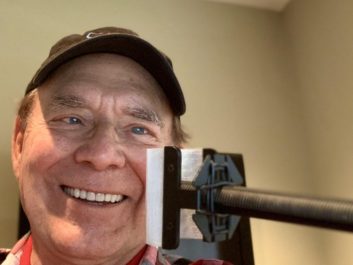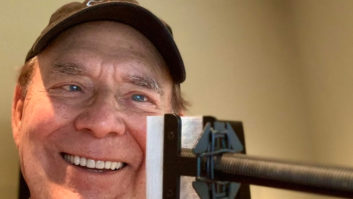
June is Microphone Month here at Radio World. This is one in a series of interviews with people who work in and around radio about the kinds of mics they love and why.
Voice veteran Don Elliot applied his music training to radio and jingles, working as a voice talent, PD, DJ, production guy and agent. Stops included WEAM(AM) in D.C., KCMO(AM/FM/TV) and KUDL(AM) in Kansas City, KISN(AM) in Portland and KOIL(AM) in Omaha.
In Los Angeles he worked at 1500 kHz in its various formats, then was hired to switch KIIS to top 40. At KFI(AM)/KOST(FM) he was the house voice for several years, and later broadcast taught at Fullerton and Saddleback Colleges.
Radio World: What’s your favorite microphone for radio on-air work?
Don Elliot: I am very appreciative of this question to ignite some independent thinking as opposed to the acceptance of the ubiquitous, oversized repurposed kick drum mic, the RE20 amongst “me too” stations that rely on crowd advice. But if it works for you, that’s great. Just know that getting out of the box won’t kill you.
Every voice and every microphone is different. That’s why there is no “one-size-fits-all.” You have to try them and listen.
For me, it’s the Sennheiser MKH 416 with a Hook Studios pop screen when I must work closer than a foot. It just finds that sweet spot in my voice without any EQ, and that’s the ideal situation. Much better to spend $1,000 on a mic that works than to spend $300 on one and then $4,000 in outboard gear to make it sound like the $1,000 mic in the first place! Simple.
RW: What’s your choice for remote or specialty work?
Elliot: It puzzles me to see ENG video work being done with omnidirectional microphones, which are known for a 360-degree pick up.
I can understand the benefit for an interviewer who does not know how to move the mic back and forth between themselves and the interviewee, but it’s at the cost of inviting unwanted ambience into the audio.
Far better to use a good cardioid and learn the technique of keeping the interviewee within the polar pattern during the interview. There is much to benefit from using its known null pattern capability when you use your mic as a tool in this way. I call it “fixing it at the source” instead of having headaches back in the studio trying to rescue bad field audio.
Above all, pay attention to the quality of your interface. I use a Centrance MicPort2 with its amazing boutique-quality preamps, 48v phantom, headphone amp and built-in limiter, to get the most out of any mic on location.
RW: If you were training someone what’s a tip you might share or common misconception to dispel?
Elliot: I would bring them to the realization that radio environments are not ideal and that must be taken into consideration in finding a mic not only ideal for the voice but also for “the room.” That’s the tip.
As for the misconceptions, one must realize that “proximity effect” does not change the pitch of your voice but instead causes an artificial low-end mushiness that can lead to loss of intelligibility in a mix or overcompensation for something that is not natural. You must consider listener fatigue in the results that you are getting.
Also, learn proper placement and which polar pattern to use! When I’m singing, I like either my U 87 in a good studio environment, or my Vanguard V13 — I heard Bill Rogers doing Disney promo work on one,which prompted me to buy — which has the advantage of remote-controlling the pattern so you can hear the changes immediately. And it’s continuously variable. I like the openness of this mic in omni, knowing that all mics sound best in omni, but we are hampered by environments into which we are forced. The V13 is a problem-solver.
RW: Other thoughts?
Elliot: When I first started at KFI/KOST, I was given the studio tour, with identical microphones in every position in the production rooms because “that way we have a consistent sound.” It was an uphill battle to convince them that to get a consistent sound you needed a variety of microphones, because no two voices are the same! I would use a ribbon microphone on a female voice that tends to fill out a higher range without making it sound artificially basic. It also helps with sibilance.
Traditionally in an air studio, one step in the right direction has been a multi EQ unit, one module for each jock in order to achieve this desired goal of consistency. I have never been a fan of EQ boost. If anything before boosting, I would start to cut some frequencies if necessary. It’s always better to be able to fix it at the source.
And although it’s probably for another subject sometime, a good microphone preamp could be the most important and prized item in the chain, which reminds us all that the “chain” only as good as its weakest link!
The best takeaway is that just because you have the tool doesn’t mean you know how to use it! Learn from the pros, but don’t be afraid to deviate and experiment.
Read more of Radio World’s coverage of microphones.







